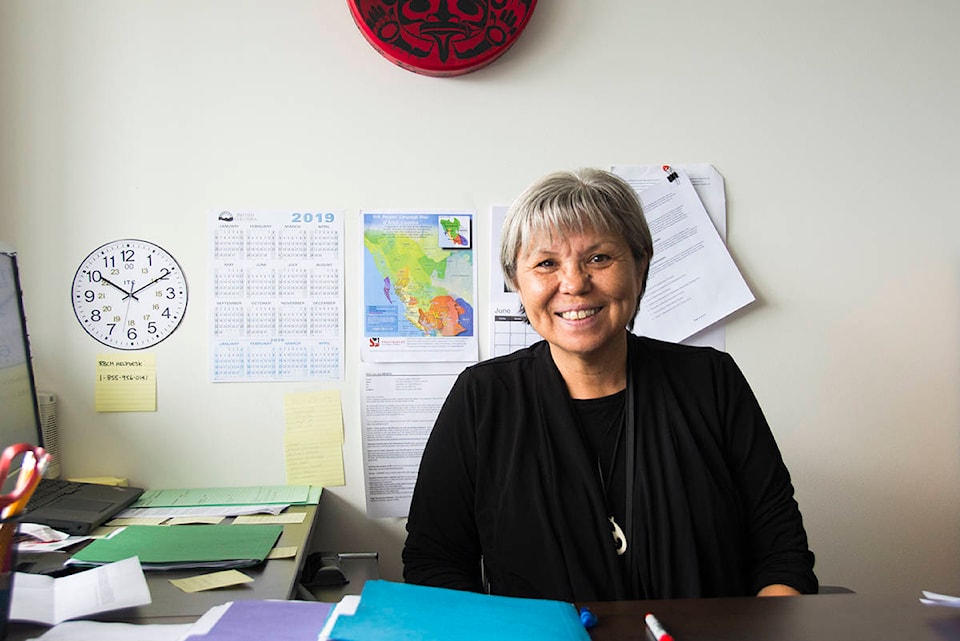Through an archived audio file, Lou-Ann Neel had the opportunity to hear her grandmother’s voice for the very first time. Through archived photos, she could see pictures of her grandmother’s face from the very same day. When she peered closer at the black and white images, she could see the masks and totem poles her grandmother had carved.
A history stolen, fractured and buried by colonialism might never be restored, but Neel is part of a group at the Royal BC Museum is working around the clock to bring the truth closer to the surface.
Neel, a Royal BC Museum repatriation specialist and member of the Mamalilikulla and Kwagiulth people of the Kwakwaka’wakw First Nation, said one aspect of the ‘truth’ in Truth and Reconciliation is acknowledging that these items and information exist.
“It’s not that the information has been inaccessible or hidden, there just hasn’t been a proactive approach to ensuring communities know what of their belongings are here in this museum.”
Merriam-Webster defines repatriation as ‘the act or process of restoring or returning someone or something to the country of origin, allegiance or citizenship,’ but in the context of of B.C.’s First Nations communities, repatriation takes on an almost entirely new meaning – items in storage at the Royal BC Museum were just kilometres away from the communities they belonged to.
But now, partially thanks to a provincial repatriation grant, items and remains “that should have never landed here” are being returned.
“It’s very powerful because its very healing,” said Neel. “The things that have been taken away from our communities are returning.”
READ ALSO: Two totem poles to come down at Victoria’s Thunderbird Park
Many of the items and remains arrived at the museum during the pot latch ban (1867-1951), coming in through Indian agents, private collectors or government officials, but often without context of the artifact’s origin.
“There were lots of way things got here but they didn’t always have information about where things came from,” Neel said. “It was difficult to return them in the first place, usually it wasn’t until the nation came to the museum and said, ‘you have one of our things that was ill-gotten, so we want it back.’”
But in the last two and a half years, that’s started to change. With the grant, a repatriation program was created and staff hired to work solely on consultation and documentation. The museum has since repatriated about 1,300 ancestral remains to their traditional homes.
“What we’ve found is the priority of almost every community that we’ve spoken with is to get the ancestral remains out of this museum and any other museum,” Neel said. “It addresses one of the biggest priorities for communities which is that they’re ancestors were taken away and the community still feels unrest that their ancestors are not resting.”
But Neel is clear, repatriation is not only about returning remains and cultural items. Some of what is being unearthed, digitized and shared are physical items like masks, carvings and weavings, but many are photographs, audio recordings and film footage, all containing interviews and snapshots of ceremonies, people and long-deceased relatives and elders.
They offer memories and history. And Neel says perhaps above all, they offer connection – something torn from many B.C. First Nations families throughout time, and through the ongoing use of residential schools – the last of which closed in the mid-90s.
READ ALSO: ‘No act of reconciliation is too small,’ says B.C. advanced education minister
“What we’re encountering is a lot of the children who were part of the ’60s scoop, were adopted out and are just now starting to find their way home,” Neel said. “Lots of information gaps are being filled in.”
Some of that information includes words never heard by current generations – formal words thought to be wiped out when ceremonies and traditions were banned by settlers.
“That’s one of the great things about the audio recordings, some of…the interviews and ceremonies have words that have fallen away from use because the ceremonies were outlawed,” said Neel. “Because of that, all the high language, the formal language you would only use in ceremony, those words are gone, or at least we thought they were gone until we started listening to these recordings.
“And this is just this museum, there’s hundreds, probably thousands more around the world.”
